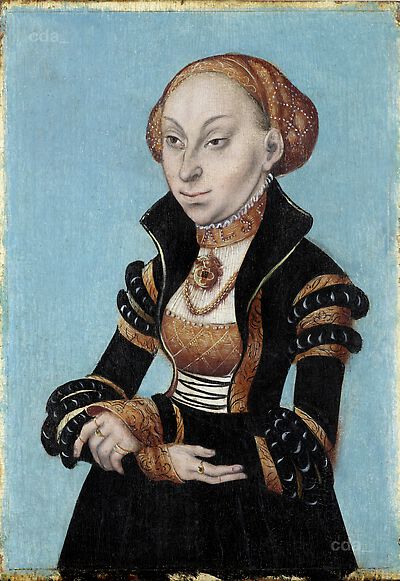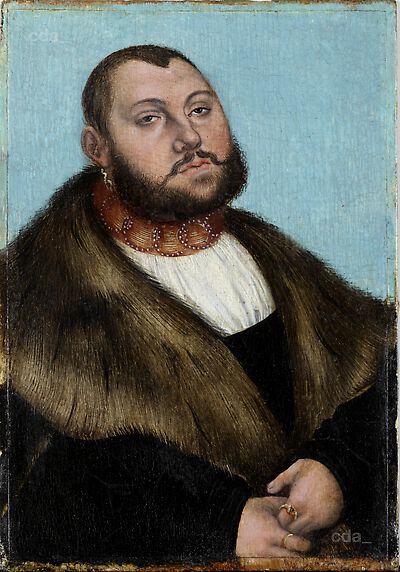The small wooden panel depicting Johanna von Cleve is stable. The wooden support is very thin, but does not exhibit any damage. The subtle execution is compromised by a now yellowed varnish application of differing thickness. Particularly in the background the varnish has a yellowed and streaky appearance. Beneath it numerous abraded areas where the blue paint layer has been thinned and the ground shows through are visible to the naked eye. The retouches covering the losses are discoloured and have darkened, lending the image a patchy appearance. Retouches are not only visible in the area at the edge of the panel beyond the incised lines over the originally exposed ground, but also in the flesh paint beneath the eyes and between the eyebrows. The robe appears to be relatively intact, only one large loss on the left beneath the left hand is apparent.
The painted surface exhibits a striking, vertical cracquelée, however the edges are not raised and the paint layers are stable.
The yellowed varnish and old retouchings were removed with a solvent mixture of ethanol and acetone. The retouchings along the edge of the panel were less affected. These had to be removed mechanically under the microscope. After the varnish and retouchings had been removed the extent of the damage was revealed with numerous small losses and abrasion of the very thin paint layers. Particularly in the blue background where the paint layers were in part so thin that the light ground shows through.
The abraded areas and losses in the paint layers on the panel depicting Johanna von Cleve are particularly evident in the flesh paint beneath the eyes as well as at the right beside the head. At the bottom left edge next to the sitter's right arm large losses exposing the wooden supports are apparent.
The edges of the panel are not painted beyond the incised lines. The paint application ends in this area, leaving the ground exposed.
After the varnish and retouchings were removed the losses where the wood was exposed were filled. The the abraded areas and the fills were retouched with gouache paint. Then a new natural-resin varnish was applied. Isolated abraded areas were adjusted employing glazes with Gamblin Conservation Colors.
Small losses and scratches on the frame were retouched with gouache paint. Abrasion on the gold profile was reintegrated with gold power bound in wax. The panel was fixed in its frame employing steel pins, which were separated from the reverse of the panel by an acid-free board.
see also pdf
- conservation treatment by Johannes Schaefer

